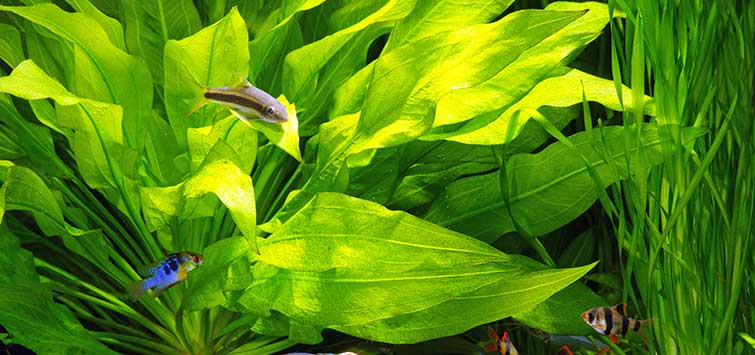Natural Composition in the Nature Aquarium
Author: Takashi Amano
A discussion of the selection and placement of rocks, driftwood, and plants to create a natural composition in the Nature Aquarium.
In the Nature Aquarium, a layout is created by placing substrate material in an aquarium first, placing layout materials next, and then planting aquatic plants. Natural rocks and driftwood are used as layout materials, and these are placed in the aquarium using natural scenery as a reference point.
Recreating Natural Scenery
Although we turn to natural scenery for reference, it is not possible to recreate natural scenery in an aquarium exactly as it is in nature. Therefore we must arrange the materials by visualizing natural scenery in our mind, and using that as a guideline for the placement of the rocks and the driftwood so they will emulate a natural scene. The more we observe various aspects of natural scenery and have them committed to our memory, the more natural our layout will look.
Layout materials are used to render a natural feel and to define the composition of a layout. Not only plants, but also rocks and fallen trees often make up the compositional elements in natural scenery, and natural layout materials are used to recreate such natural scenery in a layout. In the Nature Aquarium, rocks are sometimes used by themselves, and they are sometimes used in combination with driftwood.
Rocks and Driftwood Arrangement
In the case of an iwagumi layout in which only rocks are used as layout materials, if multiple rocks are placed over a flatly leveled substrate, the relationship of the rocks appears unnatural. In such a case, a substrate material such as soil should be placed around the rocks to tie the rocks together naturally after arranging them in the layout. If individual rocks appear small for the size of the aquarium, rocks can be made to appear larger by placing them after creating an undulation in the substrate. A natural-looking and powerful iwagumi layout can be created using these techniques.
In the case that driftwood is used as the main layout element, placing rocks around the pieces of driftwood can render a more natural feel. In addition to the rocks’ aesthetic function, they make it easier to adjust the angle of the driftwood sections during the arrangement, since rocks can help stabilize the driftwood. The rocks used for this purpose should be easy to acquire as layout materials, since they do not have to be as large as the rocks for an iwagumi layout.
There are many types of driftwood and rocks, and you can select them based on your own preferences. One thing you must keep in mind is that you should stick to one type of rock and/or driftwood in an aquatic plant layout. If you combine different types of driftwood or rocks in a layout, they will appear unnatural. Since rocks and driftwood are natural materials, even the same type of rocks or driftwood may come in different colors and textures. In such a case, the colors and textures should be matched.
Keep an Eye on Water Quality
Some rocks and driftwood affect water quality. When CO2 is injected into an aquarium, calcium and magnesium leach out of rocks and increase the total hardness. When the total hardness increases, it affects the growth of some aquatic plants. Therefore, rock such as limestone that contains a high amount of calcium carbonate is not suitable for an aquatic plant layout. If you find that rocks are increasing the total hardness and hampering the growth of aquatic plants, an ion-exchange resin that adsorbs cations can be used to reduce the total hardness.
Although driftwood does not increase the total hardness, tannic acid seeps into the water at the beginning of its use and causes the water to turn yellow. This can be resolved through repeated water changes, but it can also be resolved in a shorter period of time if activated carbon is added to your filter.
Arranging Aquatic Plants
I have discussed layout materials up to this point. However, the composition of a layout is not determined by these materials alone. The composition of a layout is also established by planting aquatic plants and creating a space, or spaces, with densely growing aquatic plants juxtaposed with the empty space(s). Therefore, it is necessary to consider the next step, planting aquatic plants, when placing layout materials in an aquarium.
In principle, a layout is divided into the foreground, the middle ground, and the background. Short aquatic plants are planted in the foreground, tall ones are planted in the background, and medium-height plants are planted in the middle ground. Looking at a layout from the front of the aquarium, empty space is created in the center, in either the left or right side, or in both the left and right sides.
You must consider where you want to create the empty space or spaces in addition to the front-to-back height difference when planting aquatic plants. If aquatic plants fill up the empty space, they destroy the balance of the composition. Therefore the empty space must be maintained using an appropriate method.
For example, the empty space can be maintained by planting no plants (or only short-growing plants) in the space, or by trimming. A prime example of the former is the use of cosmetic sand in the empty space to keep the aquatic plants out. Trimming becomes essential in the latter case if stem plants are grown in the background.
It is important to initially let aquatic plants grow naturally right after setting up an aquarium. After a period of time, however, it becomes important to preserve the layout’s empty space. So, in order to create a well-balanced composition when initially planting the aquatic plants, one should consider the future importance of maintaining the layout’s empty space.

.png?h=595&iar=0&w=2781&hash=5FD5E69473BCC22199FBFA2FB71B6033)









